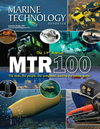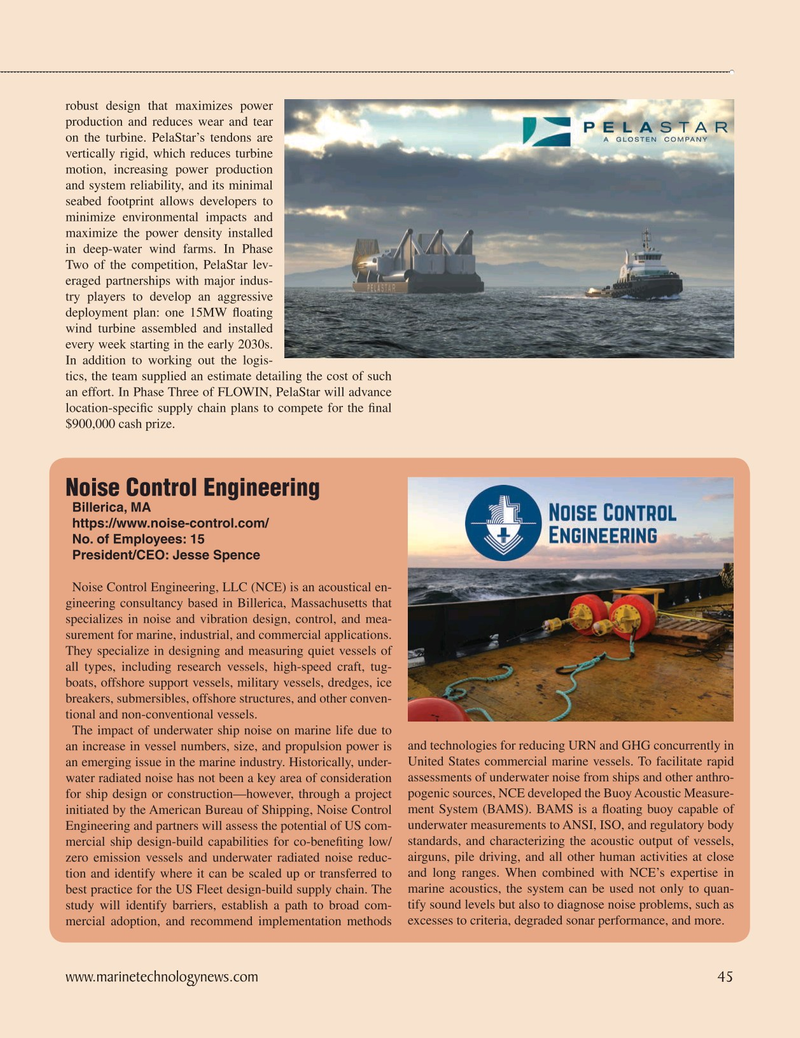
Page 45: of Marine Technology Magazine (September 2024)
Read this page in Pdf, Flash or Html5 edition of September 2024 Marine Technology Magazine
robust design that maximizes power production and reduces wear and tear on the turbine. PelaStar’s tendons are vertically rigid, which reduces turbine motion, increasing power production and system reliability, and its minimal seabed footprint allows developers to minimize environmental impacts and maximize the power density installed in deep-water wind farms. In Phase
Two of the competition, PelaStar lev- eraged partnerships with major indus- try players to develop an aggressive deployment plan: one 15MW ? oating wind turbine assembled and installed every week starting in the early 2030s.
In addition to working out the logis- tics, the team supplied an estimate detailing the cost of such an effort. In Phase Three of FLOWIN, PelaStar will advance location-speci? c supply chain plans to compete for the ? nal $900,000 cash prize.
Noise Control Engineering
Billerica, MA https://www.noise-control.com/
No. of Employees: 15
President/CEO: Jesse Spence
Noise Control Engineering, LLC (NCE) is an acoustical en- gineering consultancy based in Billerica, Massachusetts that specializes in noise and vibration design, control, and mea- surement for marine, industrial, and commercial applications.
They specialize in designing and measuring quiet vessels of all types, including research vessels, high-speed craft, tug- boats, offshore support vessels, military vessels, dredges, ice breakers, submersibles, offshore structures, and other conven- tional and non-conventional vessels.
The impact of underwater ship noise on marine life due to an increase in vessel numbers, size, and propulsion power is and technologies for reducing URN and GHG concurrently in an emerging issue in the marine industry. Historically, under- United States commercial marine vessels. To facilitate rapid water radiated noise has not been a key area of consideration assessments of underwater noise from ships and other anthro- for ship design or construction—however, through a project pogenic sources, NCE developed the Buoy Acoustic Measure- initiated by the American Bureau of Shipping, Noise Control ment System (BAMS). BAMS is a ? oating buoy capable of
Engineering and partners will assess the potential of US com- underwater measurements to ANSI, ISO, and regulatory body mercial ship design-build capabilities for co-bene? ting low/ standards, and characterizing the acoustic output of vessels, zero emission vessels and underwater radiated noise reduc- airguns, pile driving, and all other human activities at close tion and identify where it can be scaled up or transferred to and long ranges. When combined with NCE’s expertise in best practice for the US Fleet design-build supply chain. The marine acoustics, the system can be used not only to quan- study will identify barriers, establish a path to broad com- tify sound levels but also to diagnose noise problems, such as mercial adoption, and recommend implementation methods excesses to criteria, degraded sonar performance, and more. www.marinetechnologynews.com 45
MTR #7 (34-49).indd 45 10/3/2024 12:17:27 PM

 44
44

 46
46
